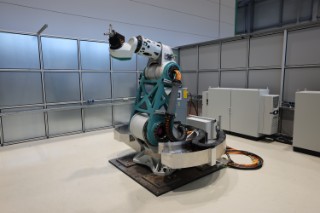
Prototype kinematics of a serial industrial robot with hybrid drives at Fraunhofer IFAM in Stade.
Fraunhofer IFAM has now developed a novel solution for the dynamic improvement of the kinematics: the hybrid drive for industrial robots.
more info
Prototype kinematics of a serial industrial robot with hybrid drives at Fraunhofer IFAM in Stade.
Fraunhofer IFAM has now developed a novel solution for the dynamic improvement of the kinematics: the hybrid drive for industrial robots.
more infoWith its expertise in the field of casting technology, Fraunhofer IFAM supports industrial customers in the casting technology implementation of an idea from the concept to the first prototype to the applicable product. Different casting processes and materials are available suitable for the respective problem.
more infoTARGETED PRODUCT IMPROVEMENTS BASED ON IN-DEPTH KNOWLEDGE OF FRICTION AND WEAR | Whether motors and pumps as a whole or their seals - almost every application product is affected by friction and wear. The consequences are high energy losses and a shortened service life of the products. To counteract this, Fraunhofer IFAM is working intensively on tribology, i.e. the question of how friction and wear can be reduced or how lubrication between components can be improved. This is because these factors are directly influenced by various things such as material selection, surface coating, or contact geometry. With its broad spectrum of competencies in the fields of materials research, coating technology and analytics, the institute offers ideal conditions for developing holistic tribological solutions.
more info
Temperature-controlled tensile tests in the temperature range between -180 °C and 200 °C with local strain measurement.
DETERMINATION OF MATERIAL AND SMALL COMPONENT PROPERTIES OF POLYMERS, COMPOSITES, AND ADHESIVE JOINTS AT CRYOGENIC TEMPERATURES | Fraunhofer IFAM offers outstanding possibilities for material testing at extremely low temperatures. In addition to tests in liquid nitrogen at -196°C, we can also carry out tests in gaseous nitrogen at temperatures down to -180°C.
more info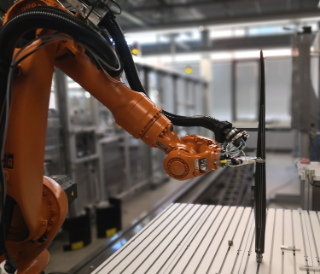
Functionalisation of large components with robots and multi-axis portal systems
MORE FLEXIBILITY THROUGH MORE AXES | The use of industrial robots and 5-axis gantries systems makes it possible to print functions such as sensors or heaters on components with complex surfaces exactly where they are needed. Various printing technologies such as aerosol jet or dispensing can be used to print structure sizes ranging from a few micrometres to several metres. The systems at Fraunhofer IFAM can thus provide component sizes ranging from a few millimetres to 10 metres with a variety of different functions, such as conductor tracks, with pinpoint accuracy.
more info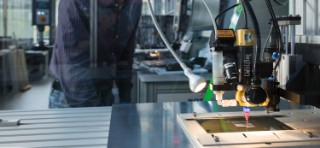
Functional integration through printing technologies
FUNCTIONAL INTEGRATION THROUGH PRINTING TECHNOLOGIES | The technology platform »Functional Printing« comprises digital and mask-based printing technologies, with which components can be functionalised specifically and precisely at the required component locations. Sensors or electronic components can thus be integrated into existing products and give the component additional or completely new properties and functions. Fraunhofer IFAM offers all important printing processes at its disposal and has in-depth material expertise. If printable inks or pastes are required for sensory applications, for example, which are not commercially available, these can be developed at Fraunhofer IFAM.
more info
Aluminum Foam Sandwich (AFS).
POWDER METALLURGICAL AND CASTING PRODUCTION OF POROUS METALS | Metal foams, porous metals and hybrid materials based on them have an attractive range of properties due to their specific structures. They are used in many areas such as automotive engineering or medical technology to improve technical systems. The Fraunhofer IFAM offers various powder metallurgical and casting processes for the production of open- and closed-cell metal foams.
more info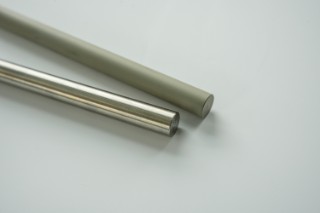
FUNCTIONALIZABLE METAL SURFACES THROUGH PLASMA ELECTROLYTIC OXIDATION (PEO) | Plasma electrolytic oxidation (PEO), also known as micro arc oxidation (MAO), is a wet chemical process that enables the production of highly functionalizable oxide layers on metals whose oxides do not have electrical conductivity, such as aluminum, magnesium, or titanium. These coatings are hard, wear-resistant, heat-resistant, and porous, making them ideal for use in aerospace, medical technology, and other high-performance industries.
more info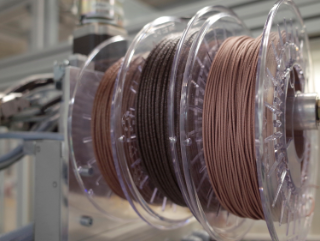
Highly electrically conducting composite for filament printing.
INTEGRATION OF HIGHLY ELECTRICALLY AND THERMALLY CONDUCTIVE FILLERS IN A PLASTIC MATERIAL | Fraunhofer IFAM is specialized in the compounding of highly filled special polymer composites and the further processing into printable composite filaments. For the processing or production of filaments from polymer composites, the institute has comprehensive know-how and the latest technologies and process techniques. The composition of the material (fillers, filler content) and the selection of the base polymer are customized according to the customer's specific requirements.
more info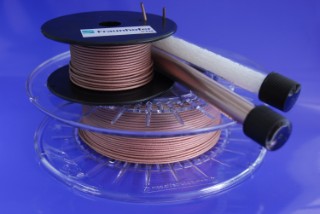
Versatile and individual thanks to special compound technology.
DO YOU NEED CERTAIN PROPERTIES OF A METAL IN A PLASTIC? | Then Fraunhofer IFAM offers the solution with its developed polymer composites! The special compound technology of Fraunhofer IFAM makes it possible to produce special composites based on a wide range of thermoplastics and elastomers which are, for example, highly electrically and/or thermally conductive.
more info